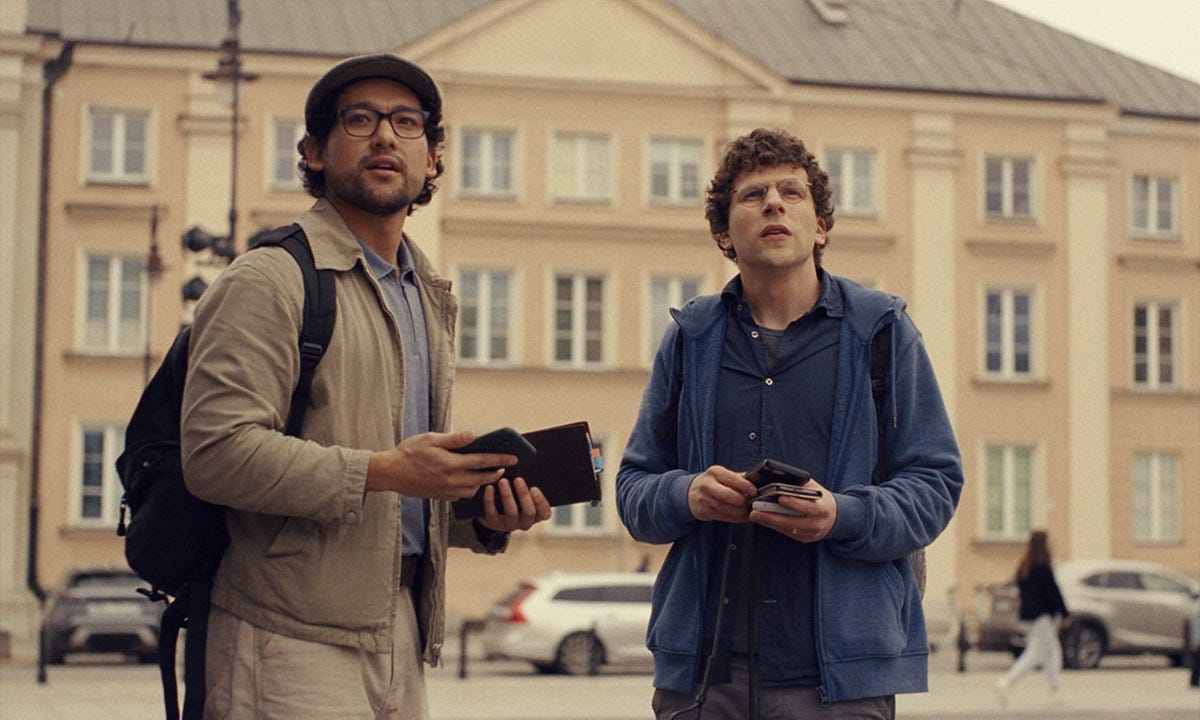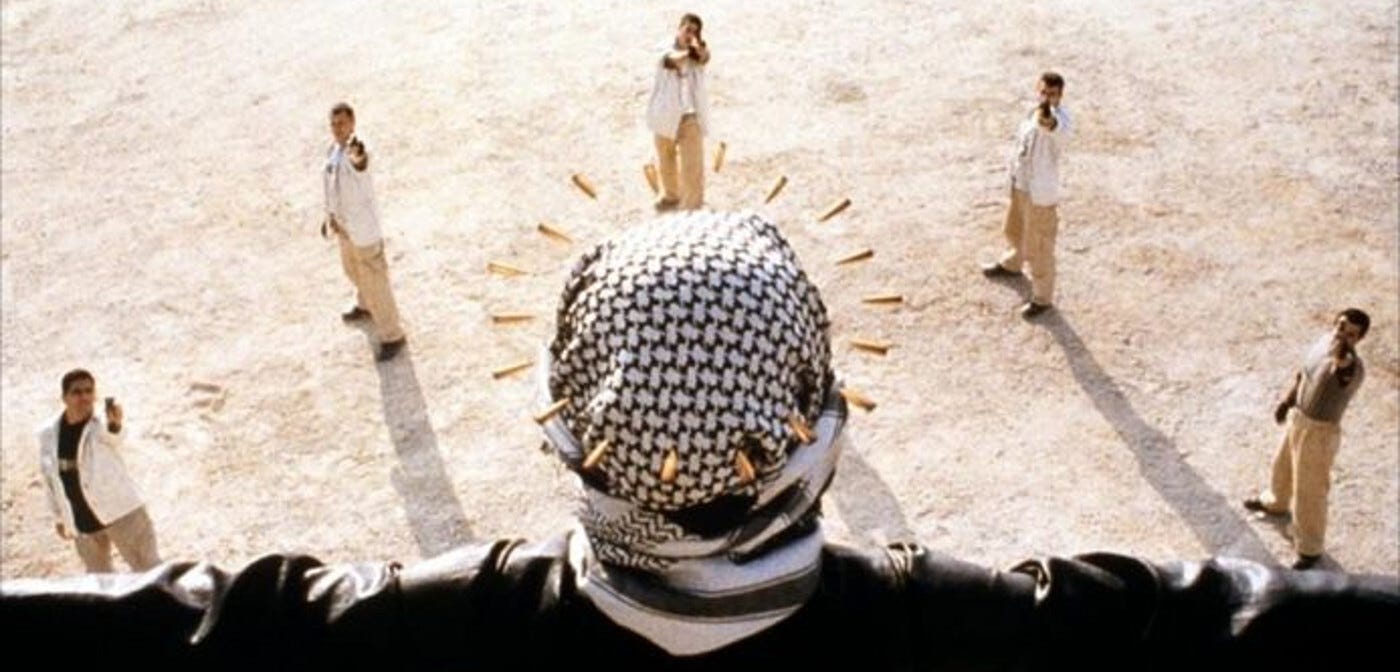Brady Corbet, Elia Suleiman and Schrödinger's Zionism
When does too much ambiguity become a cop-out?
Everything about Brady Corbet’s The Brutalist gestures at its own significance1 . Whether it’s the narrative or the meta-narrative (three-and-a-half hours! an intermission! VistaVision!), this is a film that wants to be seen as important. In an age where the work of artists is constantly devalued, it is understandable that a movie with such a grand vision, built on a foundation of deliberate artistic integrity (well… mostly), is resonating with viewers. This can be seen in its thematic concerns; Corbet is clearly interested in asking all the big questions about the friction between artistry and commerce, the American Dream™ and identity. Whether or not Corbet has an answer to these questions is a different matter.
Although I was genuinely impressed with all of the above, there is a key difference between gesturing at important themes and actually exploring them. The structure of Corbet’s film means that a number of the ideas are left ambiguous. This isn’t an inherent issue—thematic ambiguity is of course a feature of heaps of great art. However, that ambiguity works best when it has intent behind it. In the case of The Brutalist, particularly its approach to Zionism, its ambiguity means that Corbet is able to avoid taking a side.
To be clear, I don’t think Corbet is an ethnonationalist. He has praised the devastating No Other Land and his star Guy Pearce is an outspoken advocate for the humanity of Palestinian people. It’s just that the narrative of The Brutalist being an incredibly important film is given additional weight by the prominence it affords discussions of Zionism, especially because the film itself is coy on what it actually thinks about Israel. Three central characters, Holocaust survivers who are disillusioned by post-war American antisemitism agonise over aliyah (immigration to Israel) but the plot jumps through history in a way that leaves the consequences of that decision unclear. This reads as an intentional withholding of key details from the audience in order to maintain plausible deniability.

The best exploration of the politics of The Brutalist I’ve read is Noah Kulwin’s recent piece which describes the film’s reluctance to articulate a position:
Within the vast scope of The Brutalist, it is difficult to locate the meaning of Zionism, Israel, and the decision of characters to trade in the depicted cruelties of immigration in the United States for the off-screen barbarism of the new Israeli state.
The Brutalist is just one of many films released in the past year that has tried to interrogate the knotty intersection of religious, ethnic and political identity at the heart of Jewish identity. Think of A Real Pain, which features a supporting character who converted to Judaism after surviving the Rwandan genocide. The solidarities that can be formed between different peoples who have experienced unspeakable trauma is a compelling idea but, before the film can take this theme to its logical conclusion, it pivots to the much safer setting of character study. This film includes one of the most repulsive characters of 2024, Will Sharpe’s philosemitic English gentile tour guide but it is only interested in this guy in relation to Kieran Culkin’s character. Again, the film benefits from gesturing at important themes without having the courage to interrogate them.

The most rabid supporter of genocide could watch either of these films without having their worldview challenged in the slightest. The same can be said for September 5 whose title and subject seem to be designed to remind audiences of October 7 (without outright saying it of course). Or the new Captain America film which has been pre-emptively praised by the ADL for featuring an Israeli superhero. It doesn’t matter whether or not these films actually take a stance on Zionism, they benefit from the ambiguous association.
In my view, the position of these films can be described as ‘Schrödinger's Zionism’2 where they are both Zionist and anti-Zionist at the same time. They are celebrated for the way they touch on such an important theme without alienating anyone but in practice just serve to reinforce existing power dynamics.
It was fortuitous that my viewing of The Brutalist coincided with my decision to dive deeper into the work of another artist who employs the language of ambiguity. Elia Suleiman is a Palestinian director who has made four feature films in which he appears onscreen as a version of himself. Somewhere between Buster Keaton and Jacques Tati (with the comedic sensibilities of Roy Andersson), Suleiman gives a series of performances employing various degrees of clownishness as an artist who is struggling to operate under Israeli occupation. Across the films, Suleiman doesn’t give himself any dialogue with one notable exception: in 2019’s It Must Be Heaven, an American taxi driver asks where he is from and he responds “I am a Palestinian from Nazareth.”

I couldn’t help but see parallels between the decision to have the character break his silence and Corbet’s similar choices. Notably, in The Brutalist, the character of Zsófia is completely non-verbal until a scene where she announces that she is moving to Israel with her fiance. It is clear that Corbet wants us to afford this moment with gravity; although Zsófia doesn’t have a huge amount of screentime, the film is book-ended with scenes featuring her being confronted with the meaning of ‘home’.
To be clear, Suleiman is not a didactic filmmaker. The comedic conceit of his work means that audiences are invited to project their own ideas onto the film. As he is presented with the absurd degradation of life under Israeli rule, the subtle reaction shots of the director are an excellent example of the Kuleshov effect3. Suleiman is so deadpan that, if the viewer thought he supported the occupation, they might assume that these reaction shots indicated some sort of tacit approval. In fact, his first film Chronicle of a Disappearance was misunderstood by some as pro-Israel for an extended shot of a Television with Israeli flags playing the Israeli national anthem. As Suleiman said in an interview with IndieWire:
I had a very bad reaction at the Carthage Film Festival with “Chronicle of a Disappearance.” They misunderstood the irony of the use of the Israeli flag in the final scene and accused me of being a Zionist collaborator.”
The critics must missed the reverse-shot in which Suleiman’s parents lay asleep on the couch, bored to the point of exhaustion by the vulgar display of jingoism. Several films and decades of public statements later, it’d hard to accuse Suleiman of being anything other than a playful but pointed critic of Israel. What makes him a master is that he knows how to pick to moment to be unambiguous and draw a line in the sand (“I am a Palestinian”).
I wish Brady Corbet had the courage to take a similar approach to his work.
As Adam Nayman titled his review, ‘The Brutalist’ Is an Achievement—and It Knows It
‘Schrödinger's cat’ is a thought experiment in quantum physics in which a hypothetical cat in a box can be simultaneously alive and dead if unobserved.
The Kuleshov effect is a technique in film editing where an image (usually a close-up) is given additional meaning when it interacts with another image (usually a reaction shot).



